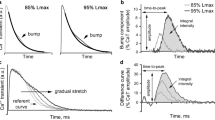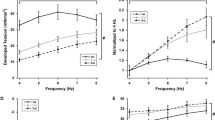Abstract
Myocardial function, intracellular calcium and levels of calcium cycling proteins were analyzed in failing and nonfailing human myocardium. Myocardial function was evaluated by the isometric force-frequency relation, and intracellular calcium was studied by aequorin light emission. When stimulation frequency was increased above 30 min−1, there was a continuous increase in isometric tension development in the nonfailing myocardium. In contrast, in failing myocardium, frequency potentiation of contractile force was blunted or inverse. As a consequence, at higher rates of stimulation, twitch tension was reduced significantly in failing compared to nonfailing human myocardium. Aequorin measurements indicated that the contractile deficit in the failing myocardium at higher rates of stimulation is associated with decreased free intracellular calcium concentration. Western blot analysis indicated that in the failing myocardium protein levels of SR-Ca2+-ATPase are significantly reduced and protein levels of Na+−Ca2+-exchanger are significantly increased. Levels of phospholamban are slightly reduced in the failing myocardium, and ryanodine receptor and calsequestrin protein levels are unchanged. There was a close positive correlation between the protein levels of SR-Ca2+-ATPase and frequency potentiation of contractile force. From these data, we conclude that in failing compared to nonfailing human myocardium 1) force-frequency relation is blunted or inverse. 2) Frequency-dependence of contractile force is closely correlated with frequency-dependence of intracellular calcium cycling. 3) Protein levels of SR-Ca2+-ATPase may determine frequency-dependence of sarcoplasmic reticulum calcium release. 4) Calcium elimination by an increased number of Na+−Ca2+-exchanger molecules may be a compensatory mechanism to prevent diastolic calcium accumulation in failing myocardium with a reduced number of SR calcium pumps.
Similar content being viewed by others
References
Arai M, Alpert NR, MacLennan DH, Barton P, Periasamy M (1993) Alterations in sarcoplasmic reticulum gene expression in human heart failure: a possible mechanism for alterations in systolic and diastolic properties of the failing myocardium. Circ Res 72: 463–469
Barry WH, Bridge JHB (1993) Intracellular calcium homeostasis in cardiac myocytes. Circulation 87: 1806–1815
Bers DM, Christensen DM, Nguyen TX (1988) Can Ca2+ entry via the Na−Ca-exchanger directly activate cardiac muscle contraction? J Mol Cell Cardiol 20: 405–414
Beuckelmann DJ, Näbauer M, Erdmann E (1992) Intracellular calcium handling in isolated ventricular myocytes from patients with terminal heart failure. Circulation 85: 1046–1055
Bowditch HP (1871) Über die Eigentümlichkeiten der Reizbarkeit, welche die Muskelfasern des Herzens zeigen. Ber Sächs Ges (Akad) Wiss 23: 652–689
Brillantes AM, Allen PD, Takahashi T, Izumo S, Marks AR (1992) Differences in cardiac calcium release channel (ryanodine receptor) expression in myocardium from patients with end-stage heart failure caused by ischemic versus dilated cardiomyopathy. Circ Res 71: 18–26
Feldman MD, Gwathmey JK, Phillips P, Schoen F, Morgan JP (1988) Reversal of the force-frequency relationship in working myocardium from patients with end-stage heart failure. J Appl Cardiol 3: 273–283
Feldman MD, Alderman JR, Aroesty JM, Royal HD, Ferguson JJ, Owen RM, Grossman W, McKay RG (1988) Depression of systolic and diastolic myocardial reserve during atrial pacing tachycardia in patients with dilated cardiomyopathy. J Clin Invest 82: 1661–1669
Gwathmey JK, Copelas L, Mackinnon R, Schoen FJ, Feldman MD, Grossman W, Morgan JP (1987) Abnormal intracellular calcium handling in myocardium from patients with end-stage heart failure. Circ Res 61: 70–76
Gwathmey JK, Slawsky MT, Hajjar RJ, Briggs GM, Morgan JP (1990) Role of intracellular calcium handling in force interval relationship of human ventricular myocardium. J Clin Invest 85: 1599–1613
Hasenfuss G, Holubarsch Ch, Hermann H-P, Astheimer K, Pieske B, Just H (1994) Influence of the force-frequency relationship on hemodynamics and left ventricular function in patients with non-failing hearts and in patients with dilated cardiomyopathy. Eur Heart J 15: 164–170
Hasenfuss G, Reinecke H, Studer R, Meyer M, Pieske B, Holtz J, Holubarsch Ch, Posival H, Just H, Drexler H (1994) Relationship between myocardial function and expression of sarcoplasmic reticulum calcium-ATPase in failing and nonfailing human myocardium. Circ Res 75: 434–442
Hasenfuss G, Mulieri LA, Leavitt B, Allen PD, Haeberle JR, Alpert NR (1992) Alteration of contractile function and excitation-contraction coupling in dilated cardiomyopathy. Circ Res 70: 1225–1232
Jorgensen AO, Arnold W, Pepper DR, Kahl SD, Mandel F, Campbell KP (1988) A monoclonal antibody to the Ca2+-ATPase of cardiac sarcoplasmic reticulum cross-reacts with slow type I but not with fast type II canine skeletal muscle fibers. An immunocytochemical and immunochemical study. Cell Motil Cytoskeleton 9: 164–74
Kim HW, Steenaart NAE, Ferguson DG, Kranias EG (1990) Functional reconstitution of the cardiac sarcoplasmic reticulum Ca2+-ATPase with phospholamban in phospholipid vesicles. J Biol Chem 265: 1702–1709
Kranias EG, Garvey JL, Srivastava RD, Sorao RJ (1985) Phosphorylation and functional modification of sarcoplasmic reticulum and myofibrils in isolated rabbit hearts stimulated with isoprenaline. J Biol Chem 226: 113–121
Kreisel W, Hildebrandt H, Schitz E, Köhler G, Spamer C, Dietz C, Mössner W, Heilmann C (1994) Immunogold electron microscopical detections of heat shock protein 60 (hsp60) in mitochondria of rat hepatocytes and myocardiocytes. Acta Histochem 96: 51–62
Kuwajima G, Tutatsugi A, Niinobe M, Nakanishi S, Mikoshiba K (1992) Two types of ryanodine receptors in mouse brain: Skeletal muscle type exclusively in purkinje cells and cardiac muscle type in various neurons. Neuron 9: 1133–1142
Lytton J, MacLennan DH (1991) Sarcoplasmic reticulum. In: Fozzard HA, Hennings RB, Haber E, Katz AM (eds) The heart and cardiovascular system, Raven Press, New York; pp 1203–1222
Mercadier JJ, Lompre AM, Duc P, Boheler KR, Fraysse JB, Wisnewsky C, Allen PD, Komajda M, Schwartz K (1990) Altered sarcoplasmic reticulum Ca2+-ATPase gene expression in the human ventricle during end-stage heart failure. J Clin Invest 85: 305–309
Meyer M, Schillinger W, Pieske P, Holubarsch C, Heilmann C, Posival H, Kuwajima G, Mikoshiba K, Just H, Hasenfuss G (1995) Alterations of sarcoplasmic reticulum proteins in failing human dilated cardiomyopathy. Circulation 92: 778–784
Movsesian MA, Karimi M, Green K, Jones LR (1994) Ca2+-transporting ATPase, phospholamban, and calsequestrin levels in nonfailing and failing human myocardium. Circulation 90: 653–657
Mulieri LA, Hasenfuss G, Leavitt BJ, Allen PD, Alpert NR (1992) Altered myocardial force-frequency relation in human heart failure. Circulation 85: 1743–1750
Mulieri LA, Hasenfuss G, Ittleman F, Blanchard EM, Alpert NR (1989) Protection of human left ventricular myocardium from cutting injury with 2,3-butanedione monoxime. Circ Res 65: 1441–1444
Philipson KD (1990) The cardiac Na+−Ca2+-exchanger. In: Langer GA (ed.) Calcium and the heart, Raven Press, New York, pp 85–108
Pieske B, Kretschmann B, Meyer M, Holubarsch Ch, Posival H, Minami K, Just H, Hasenfuss G (1995) Alterations in intracellular calcium handling associated with the inverse force-frequency relation in human dilated cardiomyopathy. Circulation 92: 1169–1178
Schwinger RHG, Böhm M, Schmidt U, Karczewski P, Bavendiek U, Flesch M, Krause EG, Erdmann E (1995) Unchanged protein levels of SERCA II and phospholamban but reduced Ca2+ uptake and Ca2+-ATPase activity of cardiac sarcoplasmic reticulum from dilated cardiomyopathy patients compared with patients with nonfailing hearts. Circulation 92: 3220–3228
Suzuki T, Wang JH (1986) Stimulation of bovine cardiac sarcoplasmic reticulum Ca2+ pump and blocking of phospholamban phosphorylation and dephosphorylation by a phospholamban monoclonal antibody. J Biol Chem 261: 7018–7023
Studer R, Reinecke H, Bilger J, Eschenhagen T, Böhm M, Hasenfuss G, Just H, Drexler H (1994) Gene expression of the cardiac sodium-calcium exchanger in end-stage human heart failure. Circ Res 75: 443–453
Takahashi T, Allen PD, Lacro RV, Marks AR, Dennis AR, Schoen FJ, Grossman W, Marsh JD, Izumo S (1992) Expression of dihydropyridine receptor (Ca2+ channel) and calsequestrin genes in the myocardium of patients with end-stage heart failure. J Clin Invest 90: 927–935
Wohlfart B, Noble MIM (1982) The cardiac excitation-contraction-cycle. Pharm Ther 16: 1–43
Author information
Authors and Affiliations
Additional information
Supported by DFG grant HA 1233/3-2
Rights and permissions
About this article
Cite this article
Hasenfuss, G., Reinecke, H., Studer, R. et al. Calcium cycling proteins and forcefrequency relationship in heart failure. Basic Res Cardiol 91 (Suppl 1), 17–22 (1996). https://doi.org/10.1007/BF00795357
Issue Date:
DOI: https://doi.org/10.1007/BF00795357




